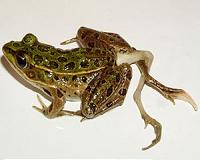 |
London, UK (SPX) Apr 29, 2011 It's one thing to recognize your childhood home when you see it in a photograph and quite another to accurately describe or draw a picture of it based on your recollection of how it looked. A new report published online in Current Biology, a Cell Press publication, offers some of the first clear evidence that monkeys, like humans, have the capacity for both forms of memory. The researchers found that rhesus monkeys can flexibly recall extremely simple shapes from memory, as evidenced by their ability to reproduce those shapes on a computer touch screen. The findings suggest that human and monkey memory is more similar than scientists knew, the researchers say. Unlike recognition, recall shows an ability to remember things that are not present in the moment, the researchers explained. Recall is necessary for planning and imagining and can increase the flexibility of navigation, social behavior, and other cognitive skills. "The ability of monkeys to recall these shapes flexibly suggests that they might be able to recollect other types of information that would be useful to them in the wild," said Benjamin Basile of Emory University. "It's exciting to speculate that they may be able to recollect the appearance of monkeys they know, what favorite foods look like, or the path they would have to take to get to a water source." Of course, it's also possible that the monkeys use their recollection in very limited ways, he added. "Maybe it's often just easier to recognize the monkey, the food, or the landmark in front of you. What we do know is that they do seem to have the ability to recall information in the lab." Earlier studies had shown that recall and recognition tests given to humans require different types of memory. But it had been tricky to devise recall tests suitable for other primates, given that they don't draw or talk. In the new study, Basile and Robert Hampton trained five rhesus monkeys on a novel recall test in which they had to reproduce a simple figure on a touch screen from memory. Those shapes included two or three boxes in a grid. After a delay, part of the shape appeared in a different location, and the monkeys had to "draw" in the rest of the shape by touching where the other boxes should be. As in humans, the monkeys remembered less in recall than in recognition tests, even under matched conditions, and recall performance deteriorated more slowly over time. Importantly, the monkeys were able to transfer their memory skill to novel shapes; their recall ability wasn't limited only to the shapes they had seen during training. The researchers say that the ability of rhesus monkeys to recall what they've seen in the past suggests that the ability to recollect does not depend on language and may have been present in our common ancestor 30 million years ago. "Recollection and familiarity likely evolved because they solved functionally incompatible problems," the researchers wrote. "For example, familiarity does not support detailed memory for context, but it is quick and resistant to distraction. Recollection is slower and more vulnerable to distraction but supports a more detailed and flexible use of memory. "Familiarity might better allow rapid responses to foods and predators under distracting conditions, whereas recollection might be necessary to access knowledge of distant food locations or past social interactions for planning future behavior."
Share This Article With Planet Earth
Related Links Cell Press Darwin Today At TerraDaily.com
 Catastrophic amphibian declines have multiple causes, no simple solution
Catastrophic amphibian declines have multiple causes, no simple solutionCorvallis OR (SPX) Apr 28, 2011 Amphibian declines around the world have forced many species to the brink of extinction, are much more complex than realized and have multiple causes that are still not fully understood, researchers conclude in a new report. The search for a single causative factor is often missing the larger picture, they said, and approaches to address the crisis may fail if they don't consider the total ... read more |
|
| The content herein, unless otherwise known to be public domain, are Copyright 1995-2010 - SpaceDaily. AFP and UPI Wire Stories are copyright Agence France-Presse and United Press International. ESA Portal Reports are copyright European Space Agency. All NASA sourced material is public domain. Additional copyrights may apply in whole or part to other bona fide parties. Advertising does not imply endorsement,agreement or approval of any opinions, statements or information provided by SpaceDaily on any Web page published or hosted by SpaceDaily. Privacy Statement |